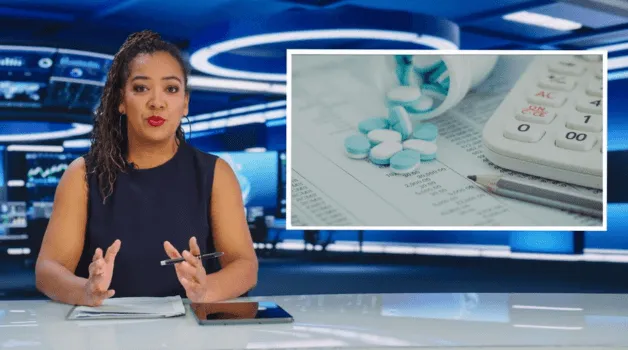Maximizing pharmacy’s role in your hospital’s revenue cycle
The 340B landscape continues to evolve rapidly, with ongoing manufacturer restrictions, new compliance hurdles, and increasing financial pressures on covered entities.
The average 340B-eligible hospital loses a substantial amount of money due to drug manufacturer restrictions on the program. Recent estimates indicate that hospitals and clinics collectively lose around $3.2 billion annually because of these restrictions, as drug companies limit 340B discounts on medications purchased through contract pharmacies. Additionally, up to $8.4 billion in 340B savings is at risk, due to increasing limitations imposed by pharmaceutical manufacturers — which could further strain the healthcare safety net and patient care services.
These financial losses have forced many safety-net hospitals to cut back on services, making it even harder for underserved patients and communities to access affordable medications and critical healthcare programs. The situation may worsen if more drug companies follow suit in restricting 340B savings.
The sad truth is that most 340B hospitals are struggling to protect their programs from further prescription-savings erosion. This reality is particularly unfortunate, given the fact that hospitals taking full advantage of ongoing advances in overcoming manufacturer restrictions and other 340B challenges are asking themselves how they can further optimize their 340B savings.
All of which is why the ultimate question for a 340B-eligible entity might be: Which group is your hospital in: The former, or the latter?
The single most promising new development for 340B hospitals
Simply stated, it’s the PBM that benefits 340B hospital patients and their employees.
It’s no secret that the nation’s largest PBMs have developed a system that routinely puts patients and providers last — particularly when it comes to making prescribing decisions for 340B patients. With the Maxor+ PBM, ProxsysRx now offers 340B health system pharmacies (retail and specialty) prescription drugs on a pricing basis that’s similar to the cost-plus model. No longer at the mercy of the largest PBMs, the hospitals we serve now have the ability to design their own formularies and networks. Which means they determine the margins their on-campus pharmacies generate on prescriptions, ensuring that those pharmacies operate on a positive-revenue basis — while, at the same time, enabling them to drive the lowest possible costs for prescriptions (including high priced specialty drugs), and pass-along lower prescription costs to their employees.
Full transparency plus pricing, patient-care control for 340B hospitals.
When ProxsysRx manages your health system’s 340B program, your providers (working with your 340B team and ours) can choose — on a per-prescription basis — whether to take the associated rebate price of a drug or the discounted 340B price on each 340B-eligible prescription. So not only will your health system benefit from lower pricing, you and your patients will benefit from the full transparency we offer you on every prescription.
By having access to comparative-medication pricing information, your pharmacists can work with your physicians to select prescriptions that best serve each patient individually. Think about that: You can ensure maximum clinical benefit for your patients, and maximum financial benefit for your 340B health system, while maintaining complete transparency on your medication costs.
Savings you can extend to your employees.
With the potential prescription drug savings, your 340B hospital could cover the copay of literally every employee prescription filled, and still generate higher margins in your own pharmacies. Moreover, with the additional remaining margins, you can further invest in the mission of caring for your community’s most vulnerable patients.
Imagine the positive impact your 340B health system could have on employee well-being, job satisfaction and overall performance by covering 100% of their prescription copays. Imagine the positive impact that could have on your patients.
Understanding the current 340B landscape
The 340B program has been subject to increasing scrutiny and regulatory oversight in recent years. Key changes anticipated or already implemented for 2025 include:
Heightened 340B audits and oversight
The Health Resources and Services Administration (HRSA) has signaled its intention to increase the number and complexity of 340B program audits it conducts. Covered entities should prepare for more frequent and detailed reviews of compliance with program requirements, including eligibility, duplicate discounts and diversion prevention.
A new drug manufacturer ploy to undermine 340B
Manufacturers continue to challenge virtually every aspect of the 340B program, from drug pricing to contract pharmacy arrangements. One of the latest ploys they’ve pulled out of their bag of tricks is a so-called “Rebate Model” for 340B pricing.
“In a nutshell,” says ProxsysRx VP Heather Brooks, “the CE would have to pay retail prices first to allow for replenishment and THEN submit documentation like they do for 340B ESP (this time with even more claims info). Then the manufacturer will approve a ‘rebate’ and send money back to the CE for the difference in the 340B and retail prices.
“This is beyond a mere adjustment in tactics. It effectively turns the entire 340B process on its head. Manufacturers are now asking already-starved nonprofit hospitals to pay significantly more upfront, with only the hope of receiving timely rebate payments.
“The good news here is that the Department of Health and Human Services (HHS) has put its foot down to stop this outrageous gambit. While many of its past responses to 340B manufacturer restrictions have been overly light, their response to this scheme has been appropriately severe. For now, the manufacturers who’ve tried it — including Johnson & Johnson, Bristol Myers Squibb, Lilly and Sanofi — have all placed the maneuver on hold.”
Adding insult to injury: Dirty tricks —
As if the tactics above weren’t enough, someone is authoring false reports and smear campaigns to undermine the 340B program in the court of public opinion. Arguably the most outrageous lie being spread was reported by The Kentucky Lantern, an independent, nonpartisan, free news service.
In an article published February 3, the Lantern reported the activities of a dark money group which calls itself Building America’s Future: “In a recent news release, [the group] claimed the 340B program is being used to ‘subsidize health care for illegal immigrants and pay for gender transition for kids’” — an obvious ploy to marshal political opposition to 340B.
The second, and far more plausible-sounding myth being spread about the 340B program is that the money supporting it comes out of taxpayers’ pockets. “How do you get people to oppose a government-sponsored program?” Brooks asks. “Tell them they’re paying for it. 340B is operated by private payers, and not one penny has ever come from taxpayers.”
340B legislative updates: States opposing manufacturer restrictions
Recent legislative proposals aim to redefine program parameters, such as expanding eligible patient definitions and revisiting covered entity eligibility criteria. Keeping up with these changes will be crucial for planning your own 340B program, moving forward.
Legislatively, we’re happy to report that more states are enacting 340B protection bills. During the month of March, at least ten more states passed bills pushing the manufacturers to reverse course.
As of 2024, at least eight states had passed laws protecting 340B contract pharmacies from drug manufacturer restrictions. Leading the charge were Arkansas and Louisiana, which successfully pressured over a dozen drug manufacturers to lift their 340B price restrictions. Additionally, in 2024, six more states — Kansas, Maryland, Minnesota, Mississippi, Missouri and West Virginia — enacted similar protection laws. Meanwhile, three other states (Delaware, Kentucky, and Rhode Island) passed similar legislation in at least one chamber of their state legislatures, and 15 more states have introduced similar bills.
“These state-level laws,” Brooks continues, “are truly beneficial for the 340B covered entities we serve. In states where the laws have been in place the longest, we’re seeing significantly more savings generated for their programs. For one of our clients, we were able to increase one pharmacy chain’s monthly 340B reimbursements from less than $10,000 to more than $100,000 a month.”
MAY, 2025 UPDATE: Executive Order 14297
President Trump’s campaign against Big Pharma evolved from threat to promise on May 12, when he signed Executive Order 14297 — which may significantly impact the 340B Drug Pricing Program, especially where Medicare reimbursements to participating hospitals and clinics are concerned.
Key Implications for 340B Reimbursements
- Potential Reinstatement of Medicare Reimbursement Cuts
The executive order signals a possible revival of Medicare reimbursement reductions for 340B-acquired drugs. During Trump’s first term, the Centers for Medicare & Medicaid Services implemented cuts that reduced reimbursements from Average Sales Price (ASP) plus 6% to ASP minus 22.5%. Although these cuts were later overturned by courts, the new order directs HHS to survey hospital acquisition costs and consider aligning Medicare payments accordingly — potentially leading to similar reductions. facilities, potentially diminishing the financial benefits hospitals currently receive under the 340B program. - Emphasis on Transparency and Direct Patient Discounts
Building on initiatives from his first term, the Trump administration is pushing for increased transparency in the 340B program. This includes proposals requiring PBMs and pharmacies to pass drug discounts directly to patients at the point of sale. While intended to reduce out-of-pocket costs for patients, such measures could transform the 340B program into a patient entitlement system, potentially impacting the financial viability of safety-net providers. - Implementation of ‘Most Favored Nation’ Pricing
Executive Order 14297 introduces a policy to align U.S. drug prices with those in other developed countries, known as “most favored nation” pricing. This strategy could lead to significant reductions in drug prices, thereby decreasing the margins that 340B-covered entities earn from the difference between discounted acquisition costs and reimbursements.
Potential Consequences for Safety-Net Providers
Safety-net hospitals and clinics, particularly those serving underserved communities, may face financial challenges due to these policy changes. The reduction in reimbursement rates and profit margins could limit their ability to fund uncompensated care and community health programs.
Critics argue that while the 340B program has been exploited by some institutions, reforms should focus on enhancing transparency and ensuring that savings directly benefit patients, rather than implementing broad cuts that could harm vulnerable populations.
Outlook
The administration’s actions suggest a concerted effort to reform the 340B program by reducing perceived abuses and ensuring that drug discounts serve their intended purpose. However, these reforms may also pose significant challenges for healthcare providers relying on 340B savings to support essential services. As the policy landscape evolves, stakeholders will need to navigate these changes carefully to balance cost savings with the sustainability of care for underserved populations.
How 340B Entities Can Optimize Their Program Benefits
1. Advanced 340B software & automated analytics
With manufacturer restrictions and compliance requirements in constant flux, tracking your health system’s 340B prescriptions is simply not humanly possible. ProxsysRx’s proprietary analytics software automates data tracking, ensuring that covered entities can efficiently manage their savings opportunities while maintaining strict 340B program compliance.
2. Full-time, expert 340B program management
Far too many health systems rely on part-time staff, with no outside support, to manage their 340B programs. That’s never worked, and it never will. A part-time staff can work well with sufficient outside support. However, in our experience, a full-time in-house staff working alone is too expensive — and lacks the depth and breadth of 340B problem-solving experience that comes with a company serving multiple health systems.
3. Overcoming manufacturer restrictions with proven strategies
Clearly, this is much more easily said than done. The challenge of overcoming manufacturer restrictions is constantly evolving, and requires a combination of analytics and human insight.
4. Getting the most from your contract pharmacies
Based on our experience managing the 340B programs of 21 health systems, here is a claim we can make with 100% certainty: Your hospital’s 340B contract pharmacy network is not what it should be.
5. Build your own retail & specialty pharmacies
Operating an in-house retail or specialty pharmacy can dramatically enhance your hospital’s 340B savings. On average, ProxsysRx-managed hospital retail pharmacies generate $750 to $1,000 in net profit per hospital bed, per month. For most 340B health systems, specialty pharmacies offer even greater 340B savings opportunities, with revenue potential as much as 600% more than traditional retail pharmacy 340B prescriptions.
More importantly, owning in-house retail and specialty pharmacies ensures that your 340B hospital’s care for your 340B patients, and your employees, stays local — within your system, in your own community — which is where it should be.
6. Use your 340B savings to expand patient services
So many of the health systems we serve have used savings generated from their 340B programs to broaden access to care, by opening new service lines and providing more comprehensive community outreach.
ProxsysRx is here to help.
To learn how ProxsysRx can help your health system succeed in an ever-changing 340B environment, contact Howard Hall anytime. howard.hall@proxsysrx.com | 214.808.2700





